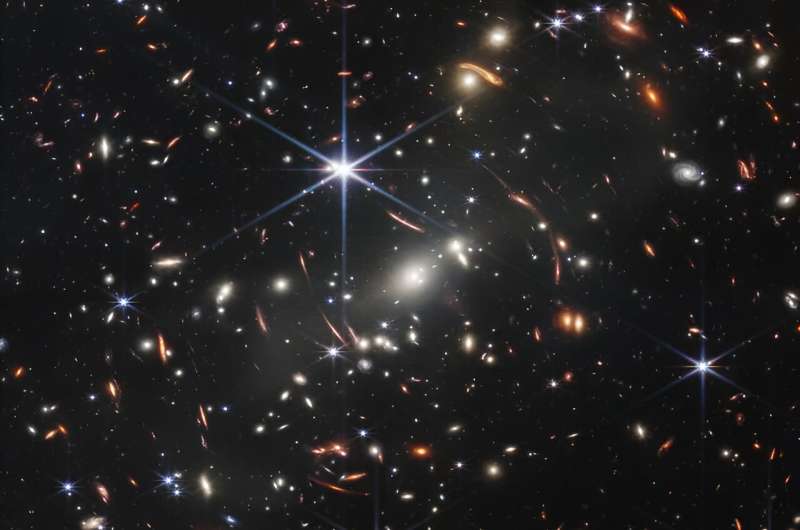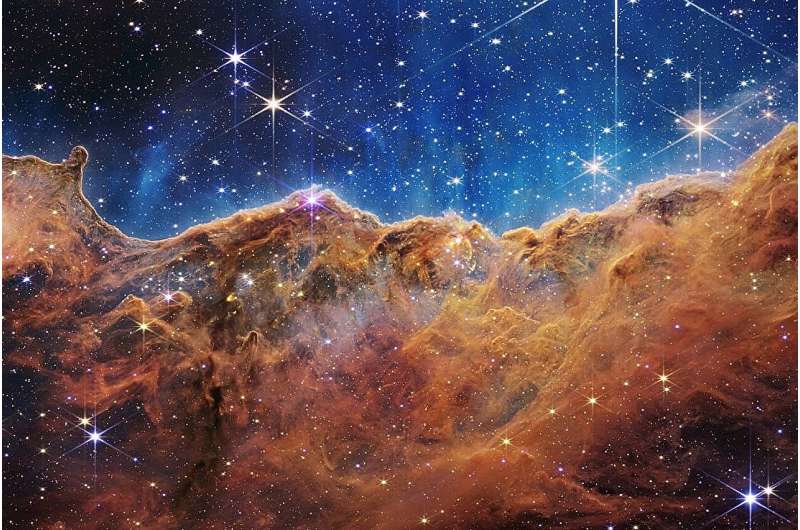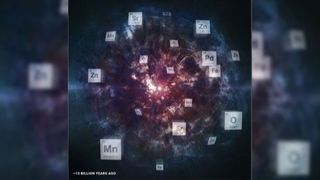James Webb Space Telescope: Finally, the edge of the universe and beyond

Launched in 2021 on Christmas Day, the James Webb Space Telescope is the most complex, precise and powerful space observatory ever built.
The telescope's unrivaled resolution and sophistication are due in no small part to the many cutting-edge devices it contains, including a guidance camera and a scientific instrument developed by researchers at Université de Montréal's Institut de recherche sur les exoplanètes (iREx).
Now these same scientists, under the direction of René Doyon, a professor in UdeM's Department of Physics, can see the fruit of their efforts and expertise, as initial data captured by the telescope has been made public.
The first photo taken by James Webb was released by U.S. President Joe Biden on July 11, 2022, and is of unprecedented color and clarity. It is the deepest, sharpest infrared image yet taken of the distant universe: A cluster of galaxies formed over 13 billion years ago.
Four more images were then unveiled live on July 12 from NASA's Goddard Space Flight Center in Greenbelt, Maryland. The images showed the Carina and Southern Ring nebulae in unparalleled sharpness, in addition to Stephan's Quintet, a visual grouping of five galaxies.
James Webb's first-ever spectroscopy of the exoplanet WASP-96 b, located 1,000 light-years from Earth, was also made public. Using this technique to determine the chemical composition of a distant object, the telescope captured the distinct signature of water, as well as evidence of clouds and haze.
Nathalie Ouellette, an astrophysicist, iREx coordinator and communications scientist for the James Webb Telescope, tells us more about these remarkable images.

The images revealed clouds of gas and dust expelled by dying stars, galactic interactions and hitherto unseen stellar birth zones. What do you consider to be the most significant discoveries?
First, like the general public, I was struck by the beauty of the images—they're so exquisite! Second, it's hard to say which image is my favorite, I guess it's like choosing your favorite child.
The exoplanet spectrum is a favorite for me, because a Canadian instrument made it, and because it proved the presence of water and clouds, allowing us to rectify discoveries that had been based on less precise and sensitive data. Usually, when you're looking at exoplanets, the data don't always align; not so with James Webb, whose data turned out to be crisp and clean and revealed some incredible things.
Also, as my research focuses on galaxy formation and evolution, I found the Stephan Quintet image spectacular, giving new insight into how galactic interactions may have driven galaxy evolution in the early universe.
So these images are truly unprecedented for the human eye?
Yes, because they show light that the human eye cannot see. The Hubble telescope looked mainly at visible light, but James Webb looks into the infrared, enabling us to detect different phenomena.
For example, nebulae are somewhat mysterious objects because they are very dusty; there is a lot of gas blocking visible light. However, with infrared, we can penetrate the dust and obtain images like those of the Southern Ring and Carina nebulae.
Are the photos the result of some kind of manipulation?
Yes, and the team that produced the images for the unveiling is amazing. Remember, it's not an easy task to make invisible light visible. It required the work of artists and scientists who were able to translate infrared into the colors we can see. And the colors are not chosen at random: they serve to emphasize certain scientific and artistic aspects of the objects.
What will astrophysicists be able to do with the photos unveiled today?
There's still a lot of analysis to be done. The images were taken in just a few days, if not weeks. We're not even talking in terms of months!
It's like opening a box full of jewels. We want to look at everything, individually, carefully. There's a lot to discover in the images. It's as if there's a galaxy hidden in every pixel. The discoveries seem endless.
The telescope's scientific operations have also just begun. Scientists and astronomers from all over the world are beginning to take possession of the telescope for their own projects.
And what's next for you at iREx's, using the Webb?
One of the first and most exciting programs to be carried out with James Webb is the observation of the planets in the TRAPPIST-1 system. This is the biggest Canadian program for the first year, and is led by Université de Montréal Ph.D. student Olivia Lim. As with the exoplanet presented today, Olivia will be looking at the atmosphere of these exoplanets, which are rocky and could therefore resemble the Earth. We're looking for a bit of an Earth twin, and maybe we'll find it in the TRAPPIST-1 system.
Provided by University of Montreal

Artist's impression of the proposed LIFE mission. Credit: LIFE Initiative / ETH Zurich
The Large Interferometer for Exoplanets (LIFE) project is an ambitious plan to build a space telescope with four independent mirrors. The array would allow the individual mirrors to move closer or farther apart, similar to the way the Very Large Array (VLA) does with radio antennas. LIFE is still early in its planning stage, so it would likely be decades before it is built, but already the LIFE team is looking at ways it might discover life on other worlds. Much of this focuses on the detection of biogenic molecules in exoplanet atmospheres.
Earlier studies looked at simulations of how our solar system would appear as an exoplanetary system. If aliens used LIFE to view our solar system from 10 parsecs away (about 32 light-years), then the array would be able to directly observe Venus, Earth, and Mars. Using a process known as phase-space synthesis decomposition (PSSD), LIFE would also be able to detect several basic molecules in their atmospheres such as water and carbon dioxide.S

Of course, lots of potentially habitable worlds are expected to have atmospheric quantities of these molecules, but that doesn’t necessarily indicate the presence of life. A stronger case for life would be made if astronomers could detect more complex molecules that are biogenic in origin, meaning that they aren’t likely to form through any geological process.
This new study focuses on three types of molecules: nitrous oxide (N2O), also known as laughing gas, methyl chloride (CH3Cl), and methyl bromide (CH3Cl). All three of these are produced by ocean biology on Earth, so their presence in an exoplanet atmosphere would be a reasonable indication of life. Based on their simulations, the authors argue that LIFE would be able to detect these molecules in atmospheric atmospheres for worlds within 5 parsecs of Earth, and should be able to gather sufficient data within 10 – 100 days of observation time. A nearby system such as Proxima Centauri, just 4 light-years from Earth would take only a few days of observation. But even for a more distant system such as Trappist-1, which is 40 light-years away, LIFE has a decent chance of detection given enough time.
The Large Interferometer for Exoplanets is currently one project being considered by the European Space Agency, but there are other life-seeking projects being proposed as well. It will be years before LIFE or another mission will be approved, and a decade or more after that before it is launched. But studies such as these are needed to make those decisions. The search is on, and finding exoplanet life could be just a matter of time.
Reference: Matsuo, Taro, et al. “Large Interferometer For Exoplanets (LIFE)-XI. Phase-space synthesis decomposition for planet detection and characterization.” Astronomy & Astrophysics 678 (2023): A97.
Reference: Angerhausen, Daniel, et al. “Large Interferometer For Exoplanets (LIFE): XII. The Detectability of Capstone Biosignatures in the Mid-Infrared–Sniffing Exoplanetary Laughing Gas and Methylated Halogens.” arXiv preprint arXiv:2401.08492 (2024).
'Barbenheimer Star' that blew up 13 billion years ago defies explanation, baffling scientists

No comments:
Post a Comment